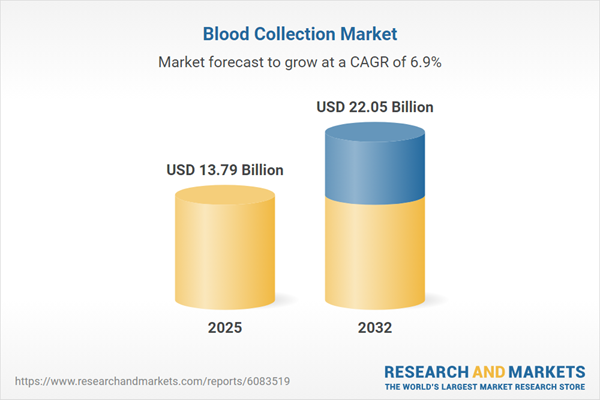Speak directly to the analyst to clarify any post sales queries you may have.
The blood collection market is undergoing swift transformation as care delivery evolves and new technologies reshape clinical processes. Amid shifting regulations and intensifying supply challenges, senior leaders are seeking robust strategies that balance patient safety, operational efficiency, and regulatory readiness.
Market Snapshot: Blood Collection Market Growth and Dynamics
The global blood collection market expanded from USD 12.91 billion in 2024 to USD 13.79 billion in 2025, projected to achieve a CAGR of 6.92% through 2032 and reach USD 22.05 billion. This momentum is supported by heightened demand for advanced healthcare solutions and a deepening emphasis on patient-centric approaches. Safety expectations are rising as care teams and laboratories seek to minimize procedural risk. Healthcare providers are adopting new technologies to drive protocol standardization and optimize collection efficiency across diverse clinical environments and global regions.
Scope & Segmentation
- Product Types: Accessories, lancets, syringes and needles, safety and standard variants, and vacuum tube systems in both glass and plastic. Each addresses procedural reliability and ensures compatibility within standard operating environments.
- Technology: Closed systems are favored for robust contamination control, while open systems retain value for adaptable use in varied clinical scenarios.
- End Users: Ambulatory care centers, diagnostic laboratories, home care environments, hospitals, and research institutes, each shaping product requirements through distinct procedural and safety needs.
- Applications: Blood banking, clinical diagnostics, and research laboratories depend on rigorously tested and adaptable collection tools to manage a range of workflows.
- Regions Covered: Americas (including North and Latin America), Europe, Middle East & Africa, and Asia-Pacific, with each market displaying specific procurement preferences and regulatory frameworks. Country-level analysis ensures a focused understanding of local trends.
- Featured Companies: Becton, Dickinson and Company, Terumo Corporation, Greiner Bio-One International GmbH, Sarstedt AG & Co. KG, Nipro Corporation, Kabe Labortechnik GmbH, Haemonetics Corporation, and Fresenius Kabi AG—each leading innovation in collection systems with a focus on reliability and compliance.
Key Takeaways: Strategic Insights for Senior Decision-Makers
- Automation and smart sensor integration are transforming workflows, improving efficiency, and supporting more reliable specimen handling across clinical settings.
- Continuous advances in design and growing focus on regulatory compliance help mitigate risks such as contamination and needlestick injuries.
- Home-based care is prompting greater demand for intuitive, patient-friendly collection kits, emphasizing user-centered design and comprehensive educational materials.
- Supply chain volatility and global trade shifts heighten the need for strategic supplier diversification, nearshoring initiatives, and robust inventory management practices.
- Collaboration among leading manufacturers, distributors, and research organizations is strengthening bundled solution offerings and advancing sustainability throughout the supply chain.
Tariff Impact and Supply Chain Resilience
Recent tariff changes in the United States have raised procurement costs and complicated logistics for core blood collection components. In response, industry leaders are accelerating the diversification of supplier networks, establishing regional manufacturing partnerships, and employing advanced demand forecasting tools. These actions reduce the risk of supply disruptions while supporting pricing stability within complex global distribution channels.
Methodology & Data Sources
Findings combine primary interviews with senior industry professionals and verified secondary research. The methodology centers on triangulated data, regulatory document analysis, and targeted market segmentation, ensuring transparency and actionable guidance for executive decision-making.
Why This Report Matters
- Empowers strategic technology selection and market entry by delivering reliable segmentation and regional analysis.
- Enables organizations to navigate operational complexities and regulatory interventions, enhancing resilience and market positioning.
- Offers actionable insight to drive investment and innovation, preparing companies for emerging trends in the blood collection sector.
Conclusion
Senior leaders can rely on these insights to adapt confidently to shifting clinical needs, regulatory pressures, and patient safety imperatives. This report supports long-term value creation by equipping organizations to anticipate change and respond with agility.
Table of Contents
3. Executive Summary
4. Market Overview
7. Cumulative Impact of Artificial Intelligence 2025
Companies Mentioned
The companies profiled in this Blood Collection market report include:- Becton, Dickinson and Company
- Terumo Corporation
- Greiner Bio-One International GmbH
- Sarstedt AG & Co. KG
- Nipro Corporation
- Kabe Labortechnik GmbH
- Haemonetics Corporation
- Fresenius Kabi AG
Table Information
| Report Attribute | Details |
|---|---|
| No. of Pages | 183 |
| Published | November 2025 |
| Forecast Period | 2025 - 2032 |
| Estimated Market Value ( USD | $ 13.79 Billion |
| Forecasted Market Value ( USD | $ 22.05 Billion |
| Compound Annual Growth Rate | 6.9% |
| Regions Covered | Global |
| No. of Companies Mentioned | 9 |









